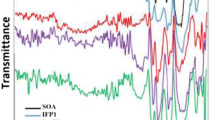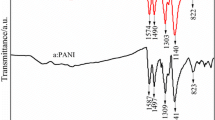Abstract
Polyaniline structures were synthesized through a chemical method using citric acid and oxalic acid as carriers and 5 μm size α-alumina particles as a template. The obtained nano-size pristine products were characterized using X-ray diffraction, infrared spectroscopy, scanning electron microscopy, optical absorption spectroscopy, photoluminescence spectroscopy and cyclic voltammetry (CV). Nanofibrous PANI was obtained with oxalic acid, nanoparticles with oxalic acid and α-alumina, net-like nanostructures with citric acid and spherical nanoparticles with citric acid and α-alumina. The high intensity photoluminescence of PANI prepared with oxalic acid as a carrier is possibly due to greater chances of exciton formation resulting from increased π-electron mobility. Electrochemical studies of PANI electrodes in 2.0 M H2SO4 were carried out at various scan rates. The CVs showed rectangular shape with added pronounced oxidation and reduction peaks.











Similar content being viewed by others
Notes
These devices are sometimes also called electrochemical double layer capacitors ECDL.
References
Oyama N, Tatsuma T, Sato T, Sotomura T (1995) Dimercaptan–polyaniline composite electrodes for lithium batteries with high energy density. Nature 373:598–600
Lee MH, Luo YC, Do JS (2005) Using PANI–PPDA/Au composite films as cathode of lithium secondary battery. J Power Sources 146:340–344
Park KI, Song HM, Kim Y, Mho SI, Cho WI, Yeo IH (2010) Electrochemical preparation and characterization of V2O5/polyaniline composite film cathodes for Li battery. Electrochim Acta 55:8023–8029
Gajendran P, Saraswathi R (2008) Polyaniline-carbon nanotube composites. Pure Appl Chem 80:2377–2395
Huang H, Feng X, Zhu JJ (2008) Synthesis, characterization and application in electrocatalysis of polyaniline/Au composite nanotubes. Nanotechnology 19:145607–145613
Zhang L (2007) Electrochemical synthesis of self-doped polyaniline and its use to the electrooxidation of ascorbic acid. J Solid State Electrochem 11:365–371
Kan JQ, Pan XH, Chen C (2004) Polyaniline–uricase biosensor prepared with template process. Biosens Bioelectron 19:1635–1640
Shabnam V, Jiaxing H, Richard BK, Bruce HW (2004) Polyaniline nanofiber gas sensors: examination of response mechanisms. Nano Lett 4:491–496
Greer AIM, Rahman F (2011) Fabrication and properties of polymer capacitors made entirely from polyaniline. Appl Phys A 103:1093–1097
Kumaki J (1986) Polystyrene monomolecular particles obtained by spreading dilute solutions on the water surface. Macromolecules 19:2258–2263
Allen SG, Aggawal SL, Russo S (1996) Comprehensive polymer science, 2nd edn. El-sevier, Ox-ford
Henselwood F, Liu G (1997) Water-soluble nanospheres of poly(2-cinnamoylethyl methacrylate)-block-poly(acrylic acid). Macromolecules 30:488–493
Tang Z, Liu S, Wang Z, Dong S, Wang E (2000) Electrochemical synthesis of polyaniline nanoparticles. Electrochem Com-mun 2:32–35
Ganesan R, Shanmugam S, Gedanken A (2008) Pulsed sonoelectrochemical synthesis of polyaniline nanoparticles and their capacitance properties. Synth Met 158:848–853
Ohira M, Sakai T, Takeuchi M, Kobayashi Y, Tsuji M (1987) Raman and infrared spectra of polyaniline. Synth Met 18:347–352
Bhadra S, Singha NK, Khastgir D (2007) Electrochemical synthesis of polyaniline and its comparison with chemically synthesized polyaniline. J Appl Polym Sci 104:1900–1904
Meixiang W (1992) Absorption spectra of thin film of polyaniline. J Polym Sci A Polym Chem 30:543–549
Stafstrom S, Bredas JL, Epstein AJ, Woo HS, Tanner DB, Huang WS, MacDiarmid AG (1987) Polaron lattice in highly conducting polyaniline: theoretical and optical studies. Phys Rev Lett 59:1464–1467
Amrithesh M, Aravind S, Jayalekshmi S, Jayasree RS (2008) Enhanced luminescence observed in polyaniline–polymethylmethacrylate composites. J Alloys Comp 449:176–179
Girija TC, Sangaranarayanan MV (2006) Analysis of polyaniline-based nickel electrodes for electrochemical supercapacitors. J Power Sources 156:705–711
Mi H, Zhang X, An S, Ye X, Yang S (2007) Microwave-assisted synthesis and electrochemical capacitance of polyaniline/multi-wall carbon nanotubes composite. Electrochem Commun 9:2859–2862
Acknowledgments
One of the authors (V.S.R.C.) thanks the Alexander von Humboldt-Foundation for a fellowship. The authors gratefully acknowledge valuable contributions by M. Schlesinger and M. Mehring in the structural analysis using XRD and support by Dr Steffen Schulze during SEM characterization.
Author information
Authors and Affiliations
Corresponding author
Rights and permissions
About this article
Cite this article
Channu, V.S.R., Holze, R., Rambabu, B. et al. Synthesis and characterization of PANI nanostructures for supercapacitors and photoluminescence. Iran Polym J 21, 457–462 (2012). https://doi.org/10.1007/s13726-012-0049-7
Received:
Accepted:
Published:
Issue Date:
DOI: https://doi.org/10.1007/s13726-012-0049-7




